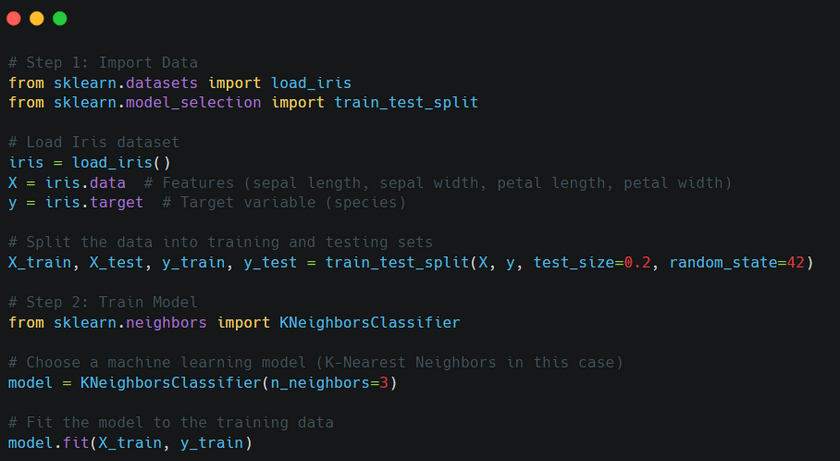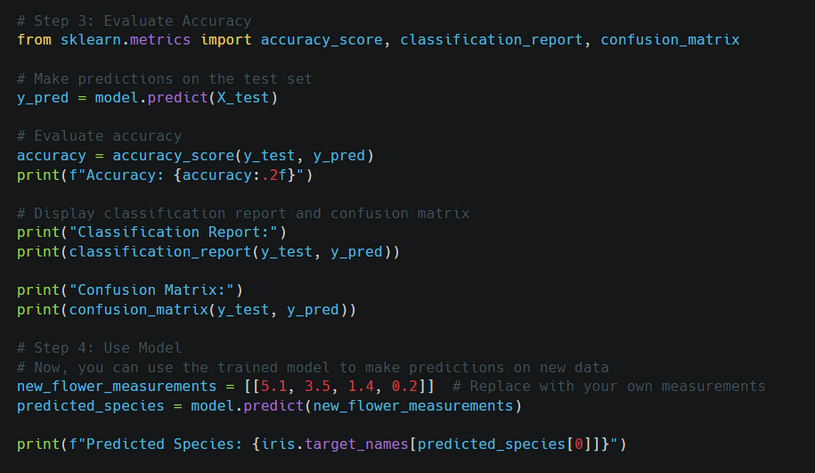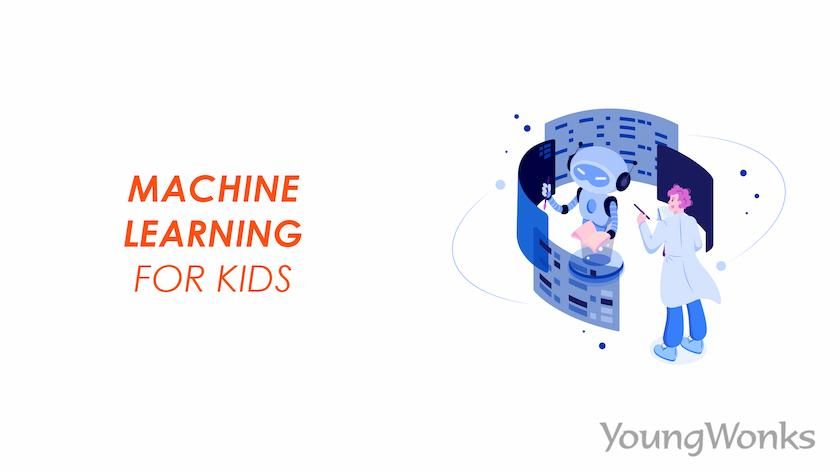Aug 20, 2024 By Team YoungWonks *
Understanding the Basics: What is Machine Learning?
Machine learning is a subset of artificial intelligence that empowers computers to learn and make decisions without explicit programming. It enables machines to analyze data, identify patterns, and improve their performance. The beauty of machine learning lies in its ability to adapt and evolve based on experiences.
Types of machine learning include:
- Supervised Learning: Supervised machine learning uses labeled datasets to train algorithms. This means input data is paired with desired outputs, like images with tagged captions. The model learns to map new unseen inputs to outputs by examining many training examples. Common real-world uses are predicting prices, detecting spam, and classifying images.
- Unsupervised Learning: In unsupervised learning, the model must learn patterns from untagged, unlabeled data. The algorithm explores the data without any guidance to discover hidden insights. Common unsupervised tasks include segmenting customer data into groups with similar traits, anomaly detection, and drawing inferences from datasets.
- Reinforcement Learning: Reinforcement learning centers on an agent interacting with an environment with the goal of maximizing rewards earned. The agent learns behavior through trial-and-error interactions. Real-world applications involve playing games, robotics, financial trading, and even managing product recommendations.
While different in approach, what these machine learning algorithms have in common is that they "learn" from patterns and features in data rather than requiring hand-coded rules. This enables much more scalable and accurate outputs from software than humans could code themselves.
Some Key terms to familiarize with:
Before diving into the world of machine learning, it's crucial to familiarize ourselves with some key terms:
- Artificial Intelligence (AI system): The broader concept of machines or software imitating intelligent human behavior. Artificial intelligence and machine learning often go hand in hand. While artificial intelligence is the overarching concept of machines mimicking human intelligence, machine learning acts as the engine driving the learning and adaptation process.
- Algorithms: Step-by-step procedures or formulas for solving specific problems. In machine learning, algorithms are used to train models.
- Neural Network: Inspired by the human brain, a neural network is a system of algorithms that attempts to recognize underlying relationships in a set of data.
- Deep Learning: A subset of machine learning that involves neural networks with multiple layers. It's particularly effective in handling complex tasks.
- Natural Language Processing (NLP): A field of AI that enables machines to understand, interpret, and generate human language.
Introducing Machine Learning to Kids: Where to Begin?
The journey into machine learning for kids often starts with hands-on activities and interactive platforms. One such platform is machinelearningforkids.co.uk, created by Dale Lane, a developer at IBM. This platform is designed specifically for young learners, offering a user-friendly environment to explore the basics of machine learning.
The Role of Programming Languages: Scratch and Python
For beginners, programming languages like Scratch and Python provide an excellent entry point into the world of machine learning.
- Scratch: Developed by the MIT Media Lab, Scratch is a visual programming language that uses blocks to represent code. It's an ideal tool for teaching kids the fundamentals of coding playfully and engagingly.
- Python: Widely used in the industry, Python is a versatile and beginner-friendly programming language. Its readability and extensive libraries make it a popular choice for teaching machine learning to kids.
- App Inventor: App Inventor is a visual programming platform that allows individuals, especially those with little to no programming experience, to create mobile applications for Android devices. It was originally developed by Google and is now maintained by the Massachusetts Institute of Technology (MIT). App Inventor simplifies the app development process by using a visual interface where users can drag and drop components to design the user interface and define the behavior of the app through visual blocks representing code.
While App Inventor itself is not specifically designed for machine learning, it can be used in conjunction with machine learning models to create Android applications that leverage machine learning functionalities.
Real-World Applications: Bringing Machine Learning to Life
Understanding how machine learning is applied in the real world is inspiring and demonstrates the practical significance of this technology. From personalized recommendations on streaming platforms like Netflix to the predictive text on their smartphones, machine learning is woven into the fabric of modern technology. Understanding the role of machine learning in everyday scenarios enhances a child's appreciation for its impact. These are some inspirational examples children can be questioned about and enable them to relate to:
- AI in Everyday Devices: Amazon Alexa and Siri: Many kids are already familiar with virtual assistants like Amazon Alexa and Siri. These AI-powered tools utilize machine learning and natural language processing to understand and respond to user commands. Exploring these devices can spark curiosity about the technology behind them.
- Netflix Recommendations: The recommendation algorithms used by streaming services like Netflix are a tangible example of machine learning at work. Kids can explore how these algorithms analyze viewing history and preferences to suggest content tailored to individual tastes.
- Autonomous Vehicles: Machine learning plays a crucial role in the development of self-driving cars. Algorithms analyze sensor data to recognize and respond to road conditions, pedestrians, and other vehicles. Predictive modeling helps anticipate potential obstacles and make real-time decisions for safe navigation.
- Healthcare Diagnostics: Machine learning algorithms are used in medical imaging, such as X-rays, MRIs, and CT scans, to assist in the detection of diseases and abnormalities. Predictive modeling helps identify potential health risks by analyzing patient data and medical histories.
Hands-On Learning: Machine Learning Projects for Beginners
Some beginner-friendly machine-learning project ideas are:
1. Creating a Chatbot with Scratch
One exciting way to introduce kids to machine learning is by building a simple chatbot using Scratch. A chatbot is a computer program designed to simulate conversation with human users. This hands-on project allows kids to understand the basics of algorithms and problem-solving.
Step-by-Step Guide:
- Open Scratch and create a new project.
- Use the "Events" and "Looks" blocks to display a greeting message.
- Incorporate "Ask" and "Answer" blocks to simulate a conversation.
- Implement conditional statements for the chatbot to respond based on user input.
2. Recognizing Patterns with Machine Learning Models:
Another engaging project involves using pre-built machine learning models to recognize patterns in data. Platforms like machinelearningforkids offer a variety of projects that allow kids to train models for image recognition, text classification, and more.
Steps to Follow:
- Choose a project category (e.g., image recognition).
- Collect and upload a dataset related to the chosen category.
- Train the machine learning model using the provided tools.
- Test the model by inputting new data and observing its predictions.
3. Predict Handwritten Digits:
Classic machine learning dataset of images of handwritten digits. Experiment with different models to get the highest accuracy in deciphering messy handwriting.
4. Language Translator:
Machine translation models allow translation from one language to another. English to French is a great starter dataset in this field called NLP (Natural Language Processing).
5. Sentiment Analyzer:
Sentiment analysis models classify text as positive or negative reviews. Build your own model to analyze product feedback, movie reviews, or social media posts.
6. Recommender System:
Recommender systems power real-world apps like Netflix and Amazon. Build your own music or video recommender that suggests new titles based on previous likes/dislikes.
Building a Simple Machine Learning Model
To understand machine learning basics we'll work through a basic project example using Python:


Step 1 : Import Data: We'll use a common dataset called Iris flowers that includes measurements like petal/sepal width/length, and species categories. This labeled dataset will serve to train our model.
Step 2: Train Model: We choose a machine learning model and "fit" it to the training data using a library like Scikit-Learn. This allows the model to learn patterns within different species of flowers.
Step 3: Evaluate Accuracy: We split the original data so we can hold back some flowers and predict their species. We compare model predictions against actual labels to evaluate performance.
Step 4: Use Model: Now our model is ready for use! We can pass measurements from new flowers and have it predict the most likely species automatically using the patterns it learned.
And there you have it - a machine learning model to categorize different species of flowers based on measurements using Python!
This demonstrates the basics of teaching models to learn from historical training data and one can build their own machine model too.
One can choose some starter data sets from Kaggle or UCI to build basic models, evaluate accuracy, and then use machine model to make predictions.
Digging Deeper: Advanced Concepts and Resources
For young learners eager to delve deeper into machine learning, exploring advanced concepts can be both challenging and rewarding.
- Deep Learning with TensorFlow: TensorFlow, an open-source machine learning framework developed by Google, introduces kids to the world of deep learning. Deep learning involves neural networks with multiple layers, enabling computers to handle complex tasks such as image and speech recognition.
- Data Science and Machine Learning Algorithms: Understanding the fundamentals of data science and various machine learning algorithms is crucial for building a strong foundation. Concepts like supervised learning, unsupervised learning, and reinforcement learning can be explored through tutorials and interactive exercises.
Learning Machine Learning: A Journey of Discovery
The process of learning machine learning involves grasping the basics, experimenting with projects, and gaining a deeper understanding of the underlying principles. Kids can learn machine learning by actively engaging in hands-on activities, leveraging online platforms, and participating in tutorials. To a Gateway to Exploration,the website machinelearningforkids serves as a valuable resource for young learners and educators alike. Offering a user-friendly interface and a variety of projects, it acts as a gateway for kids to explore the fascinating world of machine learning. The platform's accessibility and interactive nature make it an ideal starting point for both educators and students.
Unleashing the power of machine learning for kids involves providing them with accessible tools, engaging projects, and real-world applications. By introducing concepts through hands-on activities, using platforms like Scratch and Python, and exploring advanced topics like deep learning, kids can develop a foundational understanding of machine learning. Moreover, understanding the intersection of computer science and machine learning, as well as recognizing the presence of machine learning in everyday life, enhances their appreciation for the technology. As we nurture the next generation of innovators, integrating machine learning into education becomes a crucial step in preparing kids for the evolving landscape of technology.
The Future of Machine Learning
The future of machine learning is all about making our lives easier, more fun, and helping us do incredible things together!
As this technology continues improving, machine learning has incredible potential to solve meaningful problems across industries like healthcare, education, business, and more. We are still just scratching the surface on what supervised learning, reinforcement learning, and artificial intelligence can achieve. Understanding the foundations of how machines can mimic human learning patterns is crucial for the next generation. Kids interested in the field can start learning now through interactive courses, experimenting with models, and creating their own projects.
The future looks bright for using machine intelligence to improve lives. With a core understanding of what drives this technology, kids can start paving their own path into this exciting field! Understanding the essential features of a computer can significantly enhance one's ability to utilize this powerful tool effectively. Computers come with various hardware components, such as the central processing unit (CPU), which acts as the brain of the machine, and memory (RAM), which allows for the storage and quick access of data. Additionally, peripherals such as keyboards, mouse, and monitors enable user interaction. For those keen on delving deeper into the world of computers and coding, numerous resources are available.
YoungWonks offers Coding Classes for Kids, including Scratch Programming specialized Python Coding Classes for Kids and Raspberry Pi, Arduino, and Game Development Coding Classes, Oops-based concepts and Machine Learning, Artificial Intelligence curriculum, all taught for 9+ years. These classes are designed to nurture future tech enthusiasts by providing hands-on learning experiences in various coding environments.
*Contributors: Written by Prasanna MG; Edited by Disha N; Lead image by Shivendra Singh

